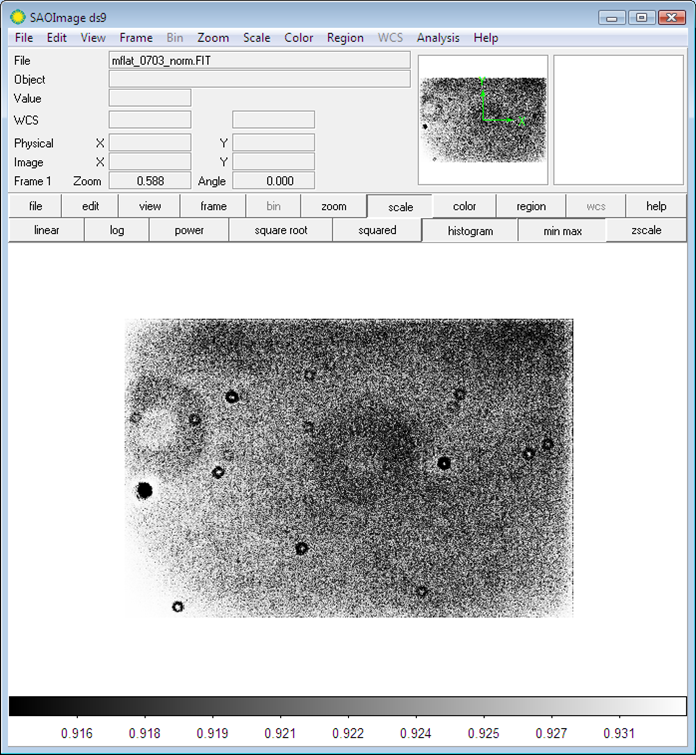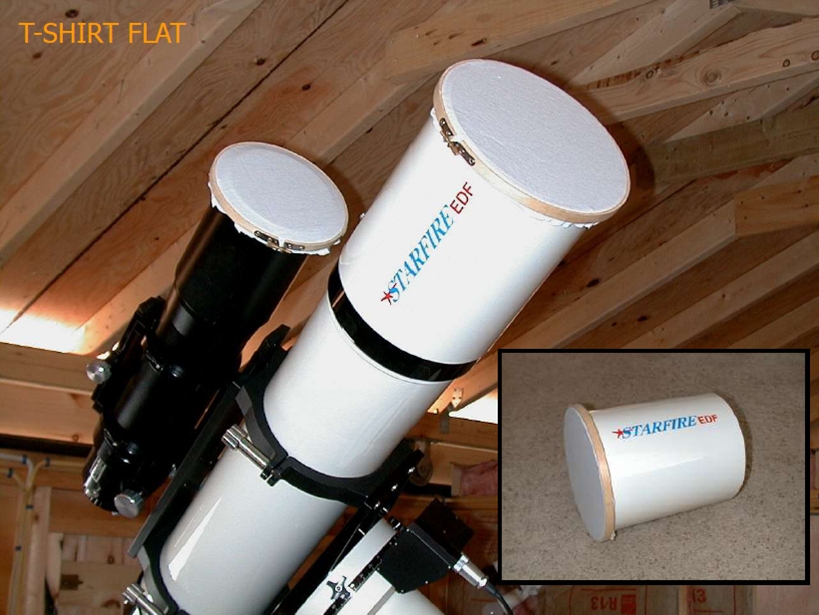Flat-fields are taken immediately preceding a telescope observation session. Their purpose is to correct for any uneven illumination on the CCD surface. Uneven illumination typically occurs as a result of vignetting due to the optical properties of the device or due to uneven background illumination in the exposure environment. Flat-fieds may also reveal areas of uneven gains or dark currents in the CCD detector, providing an indication of CCD Defects.
Dust Particles
Another advantage of taking flat-field frames is that they also correct for dust particles which may accrue on the external telescope aperture, internal telescope mirrors or CCD lens. Dust particles result in the appearance of "dust doughnuts" in the final image. This uneven illumination is again unwanted noise in the final image so it is therefore advisable to remove as many of these dust particles as possible by cleaning all external surfaces through which photons will be incident before taking a flat-field frame.
Exposure Technique
When taking a flat field, an astronomer must follow 2 principles:
- The maximum number of counts in any one flat-field pixel should not exceed half the stated Full Well Capacity for the CCD imaging device
- The image taken must be diffuse and out of focus, so that no structure is able to be resolved by the imaging device
The first principle is relatively straightforward to follow - simply choose a suitably lit background environment and take an appropriate length exposure so that an appropriate number of pixel counts is detected to produce an accurate flat-field.
The second principle states that incident light must be diffuse before entering the telescope aperture. There are a variety of methods by which this can be achieved:
- Dome Flat
- Light-Box Flat
- Sky Flat/Twilight Flat
- T-Shirt Flat
Dome flats require that an exposure be taken on a uniform white surface on the inside of an observatory dome. It is important that the incident light is uniformly illuminated if this method is used.
Light-box flats follow a very similar principle to dome flats, except a light box is used to provide the uniform light source.
Sky flats should be taken at twilight when the incident light in the sky is uniform and bright enough to reach the 1/2 Full Well Capacity limit.
T-shirt flats utilise a uniform white T-shirt as a diffuser before light is incident on the telescope. T-shirt diffusers are placed over the telescope aperture, as can be shown in Fig. 2.
It is often found that combining a diffuser such as a T-shirt and taking a twilight or dome flat produces the best flat-field results. For the 2010-11 BSc Project, an optimal flat-field was able to be taken by taking a dome flat using a t-shirt covering the telescope aperture as a diffuser. The Full-Well Capacity for the SBIG ST-7E KAF0401E CCD chip is 60,000, so a maximum pixel count of 30,000 was achieved during the flat-field exposure. After normalization, the image shown in Fig. 1 was produced before the observing session on 07.03.11.
Further reading on flat-field exposure techniques can be found on the links page.
Data Reduction
Flat-field correction is usually the final stage in the data reduction process. It requires that an image be divided by its corresponding flat-field frame so that areas which are dimly illuminated in the flat-field frame become illuminated and vice-versa for the brighter areas. This corrects for any vignetting, uneven illumination and dust doughnut effects in the final calibrated image.
In order to perform flat-field correction, a suitable flat-field frame must first be taken using the techniques described above. The flat-field must then be normalized so that the maximum pixel value equates to 1.0. This can easily be done on programs such as IDL by simply dividing every pixel in the array by the maximum pixel value. An image can then be divided by this normalised master flat-field frame to complete the flat-field correction process.
By the nature of flat-fields, they must be taken immediately preceding an observing session. Between observing sessions for a given device, the background illumation experienced by the optical setup or the number of dust grains incident on the device will have almost certainly varied. A generic master flat-field frame can therefore not be generated for a particular device and the flat-field re-calibration process must be repeated before each night of observing.

